キーワード: ビッグデータ、e- コーマス、CRM、アルゴリズム
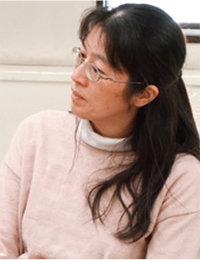 皆さんは「工学的である」とはどういうことだと思われますか? 工学が工学たる所以は、再現性があること、つまり同じインプットをすれば同じアウトプットが得られることにあります。インプットとアウトプットの間にある関数の構造を定めることが、工学の価値だと言えるでしょう。リサーチユニット「価値創造」は、企業が抱える経営上の課題に対し工学的にアプローチする研究者の集まりです。
皆さんは「工学的である」とはどういうことだと思われますか? 工学が工学たる所以は、再現性があること、つまり同じインプットをすれば同じアウトプットが得られることにあります。インプットとアウトプットの間にある関数の構造を定めることが、工学の価値だと言えるでしょう。リサーチユニット「価値創造」は、企業が抱える経営上の課題に対し工学的にアプローチする研究者の集まりです。
購買行動を確率論的に理解する
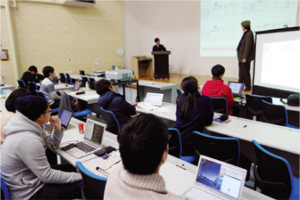
図1:ミーティングの様子
企業・研究者・学生が共通の課題に一丸となって取り組む
経営という複雑な事象に工学的にアプローチしようという試みはアメリカで始まったもので、非常に長い歴史があります。それは基本的に、経営を財務・生産・マーケティングなどの機能別に分解したうえで分析し、それらを張り合わせて全体を理解するというやり方をとってきました。しかし、市場環境が複雑で変化の速い現代では、このような張り合わせ型のアプローチは通用しにくくなっています。そこで私たちは、企業経営において最も重要なファクターである消費者の購買行動を、確率理論や最適理論を応用して理解し、現実の経営に組み込むということに取り組んでいます。企業が現実に抱えている課題を、その企業のメンバーと私たち研究者・学生が一つのチームとなって解決しようとしているのです(図1)。
スマートフォンアプリの将来のダウンロード数予測
私たちがFULLER社という企業と取り組んでいるプロジェクトをご紹介しましょう。近年、スマートフォン市場は急成長を遂げており、世界中で膨大な数のアプリケーションが開発され
ています。消費者のスマートフォン上では、日々新たなアプリがインストールされたり削除されたりしているのです。FULLER社と私たちは、ユーザーのアプリ所持状況・使用実態などのデータを最新の数理的手法を用いて分析し、新たに開発されたアプリの将来のダウンロード数を確率論的に予測することにグループごとに取り組んでいます。
既存の将来予測の方法論であるARIMA(Auto Regressive Integrated MovingAverage)モデルには、過去の時系列データの慣性力に影響を受けすぎるという問題点がありました。そこで住田先生のグループでは、ARIMAモデルに非斉時マルコフ連鎖を組み合わせることで予測の精度を高めるとともに、予測値の確率分布を算出することができるアルゴリズムの開発に取り組んでいます(図2・3)。これが実用化できれば、世界中のアプリ開発企業に対して全く新しいサービスを提供することが可能になるでしょう。
私たちは、他にもユニットを構成する各先生が中心となるグループ単位で研究を進めています。、互いに相補的もしくは相殺的なアプリの組み合わせを発見するアルゴリズムの開発や、特定のアプリに着目してスマホを複数のクラス(安定型、回復型、変動型など)に類別しその構成比の変化を予測するといった問題に取り組んでいます。
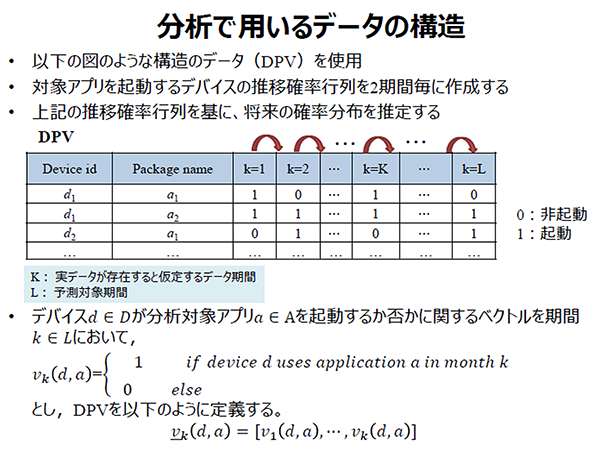
図2:ダウンロード数予測に用いるデータの構造
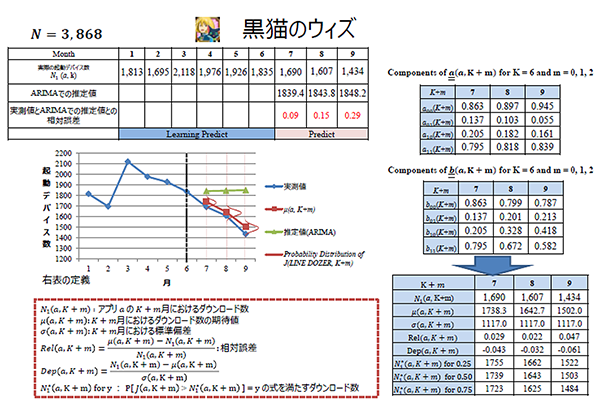
図3:開発中のアルゴリズムによるダウンロード数予測の例。ARIMA モデルよりも精度の高い予測が可能
社会への貢献・実績
● 急成長するアプリケーション市場に、新たな分析手法や価値創造の方法論を提案
● 企業の実データを分析してディスカッションを繰り返すことによる実践的教育
Engineering of business management
Unit members : Yoshise, Akiko
Unit name: Value Creation
Keywords: big data, e-commerce, CRM, algorithm
 What do you think is “engineering”? An act is regarded as engineering if it is reproducible, or when the same output can be obtained from the same input. The value of engineering lies in the structure of functions between inputs and outputs. The research unit: “Value Creation”, consists of researchers who address management problems faced by companies, using engineering approaches.
What do you think is “engineering”? An act is regarded as engineering if it is reproducible, or when the same output can be obtained from the same input. The value of engineering lies in the structure of functions between inputs and outputs. The research unit: “Value Creation”, consists of researchers who address management problems faced by companies, using engineering approaches.
Understanding of purchasing behaviors based on probability theories

Figure 1: A scene of a meeting Companies, researchers, and students in collaboration with each other to address an issue
Engineering approaches to business management, which were initiated in the U.S.A., have a long history. In these methods, the functions of management, such as finance, production, and marketing, are analyzed separately, and the analysis results are integrated to comprehend the management itself. However, these approaches are often ineffective in modern times, in which the market environment is complex and changes at a high rate. In this context, the research unit aims to comprehend the purchasing behaviors of consumers – the most important factor of business management, by applying probability and optimal theories, and incorporate the factor in actual business management. The staff of a company, researchers of the unit, and students organize a team to address problems faced by the company (Figure 1).
Prediction of the expected numbers of smart phone application downloads
Let me introduce our joint project conducted with a company called Fuller, Inc. As the market for smart phones has grown at a significant speed in recent years, countless numbers of applications have been developed around the world. New applications are installed in and uninstalled from consumers’ smart phones every day. Multiple groups consisting of members of Fuller, Inc. and the research unit analyze data on the status of the possession and use of applications by users, using the latest mathematical methods, and predict the number of newly developed applications expected to be downloaded in the future based on probability theories.
The ARIMA (Auto Regressive Integrated Moving Average) model, an existing future forecast methodology, has a problem that it is significantly influenced by the inertial force of past time series data. The group led by Professor Sumita has combined the ARIMA model with inhomogeneous Markov chains to improve the prediction accuracy, and is developing an algorithm to calculate the probability distribution of predicted values (Figures 2 and 3). If the algorithm is put into practical use, we will be able to provide completely new services for companies around the world involved in the development of applications.
Each group led by professors who are members of the unit also conducts research. The groups develop algorithms to identify combinations of complementary or compensating applications, categorize smart phones into classes (stable, recovery, and fluctuation types, etc.) by focusing on specific applications, and predict changes in the composition ratio.
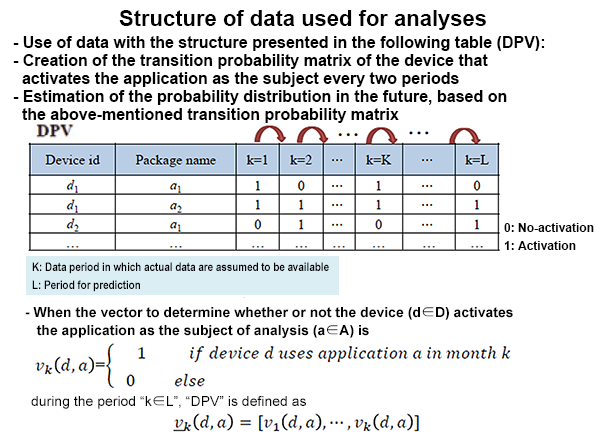
Figure 2: Structure of data used to predict the number of downloads
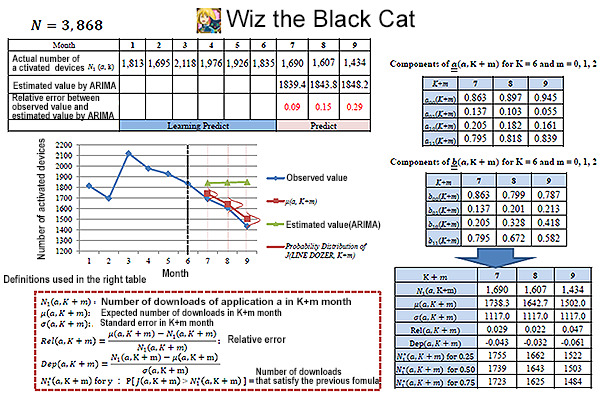
Figure 3: An example of the prediction of the number of downloads using an algorithm in the process of development
Social contributions and achievements
– Proposals of new analysis methods and methodologies for value creation to the rapidly growing application market
– Practical education through analyses of actual data on companies and discussions
Interviewed on December 18, 2014
